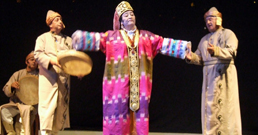The name Merv, an ancient city in Central Asia, which existed during the Achamenian Empire, was also known as “Mergu” and “Mergianeh.” However today this ancient city has been destroyed and in its place exists a small city called Mary, which is located in the Republic of Turkmenistan.
Merv was on the Silk Road and many peoples from different cities migrated here. Khorasanies who migrated to the city of Merv from contemporary Iran brought with them their music, first here, and then to Bukhara. The combination of their music with the culture of Bukhara, currently known as “Mervigi” or “Mawrigi” is replete with low and high notes full of happiness and sorrow. This particular music developed during the end of the 19th century and the beginning of the 20th century in the Emirate of Bukhara.
Bukharan aristocrats used the term “Mervi” for Iranians, who during different times migrated from different parts of ancient Khorasan, especially from the city of Merv to Bukhara.
Given that during that time music from Iran and the Emirate of Bukhara was close to the Mervigi style of music it was quickly adopted in Bukhara. Mervigi singers were singing mainly popular rubaiyat, which they had brought with them to Bukhara. Gradually Mervigi was combined with local Bukharan music, however the two did not completely merge and Mervigi maintained its many characteristics. This form of music is still common in Bukhara today.
The main instrument in this form of music is the daf, which is quite common in local Tajik Central Asia music. However the singing of Mervigi singers is more similar to the art of Iranian and Azeri traditional singing. Usually Mervigi songs have a soft introduction and are followed by passionate movements, which are also accompanied by dancing. Popular, sad and mournful rubaiyat gradually turn into witty and humorous improvisations at which time dancers enter the stage using rapid hand and leg movements. Previously only young men performed these dances, but now all the dancers are women.
Currently in Bukhara’s philharmonic orchestra a folkloric Mervigi group is active, whose many members are descendants of the Iranians who migrated to Bukhara from different cities in Khorasan during the past centuries. They say that they have learned the tradition of Mervigi singing from their ancestors and intend to pass it on to their children so that Mervigi singing will continue to exist in Bukhara. Some of these members also teach Mervigi singing at the fine arts university. Last year in Tajikistan a book entitled Mervigi was published. The authors of this book, Nizam Nurjanov and Bahrinnisa Qabilova, have written the music for Mervigi songs in this book so that musicians and students can learn how to play Mervigi songs.
Many cultural and musical experts in Tajikistan believe that there is a strong demand for Mervigi singing skills in Tajikistan. Due to the collapse of the Soviet Union and the distance between Bukhara and the cultural sphere of Tajikistan this type of music, which is an element of the musical culture of the Persian-speaking region, could soon be forgotten. For this reason, there exists a Mervigi singing ensemble at Tajikistan’s musical conservatory for the students of Shashmaqam (Tajik traditional music).
In this multimedia report you can watch the performances of a Bukharan Mervigi band accompanied by a description from Professor Nizam Nurjanov.


